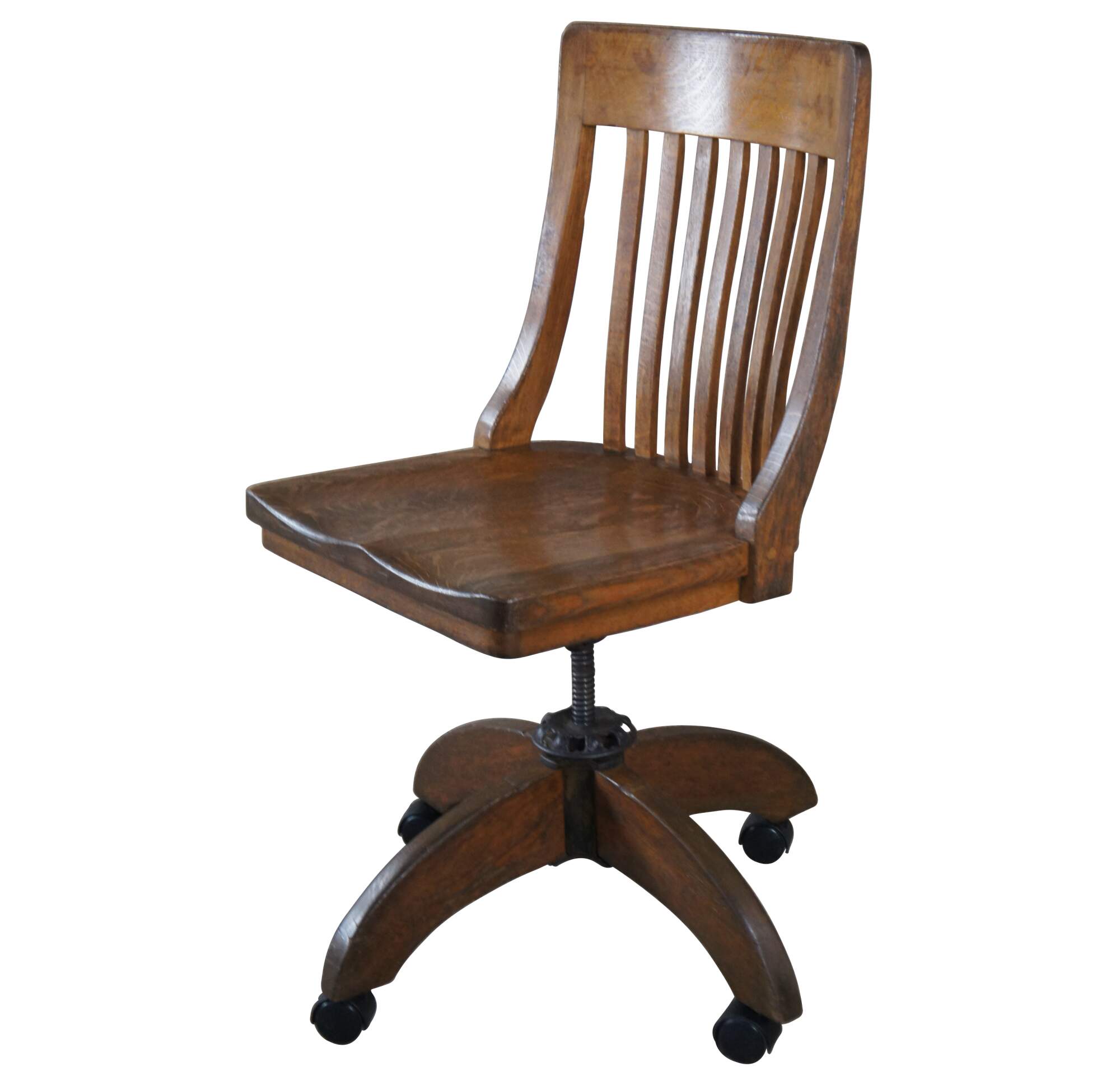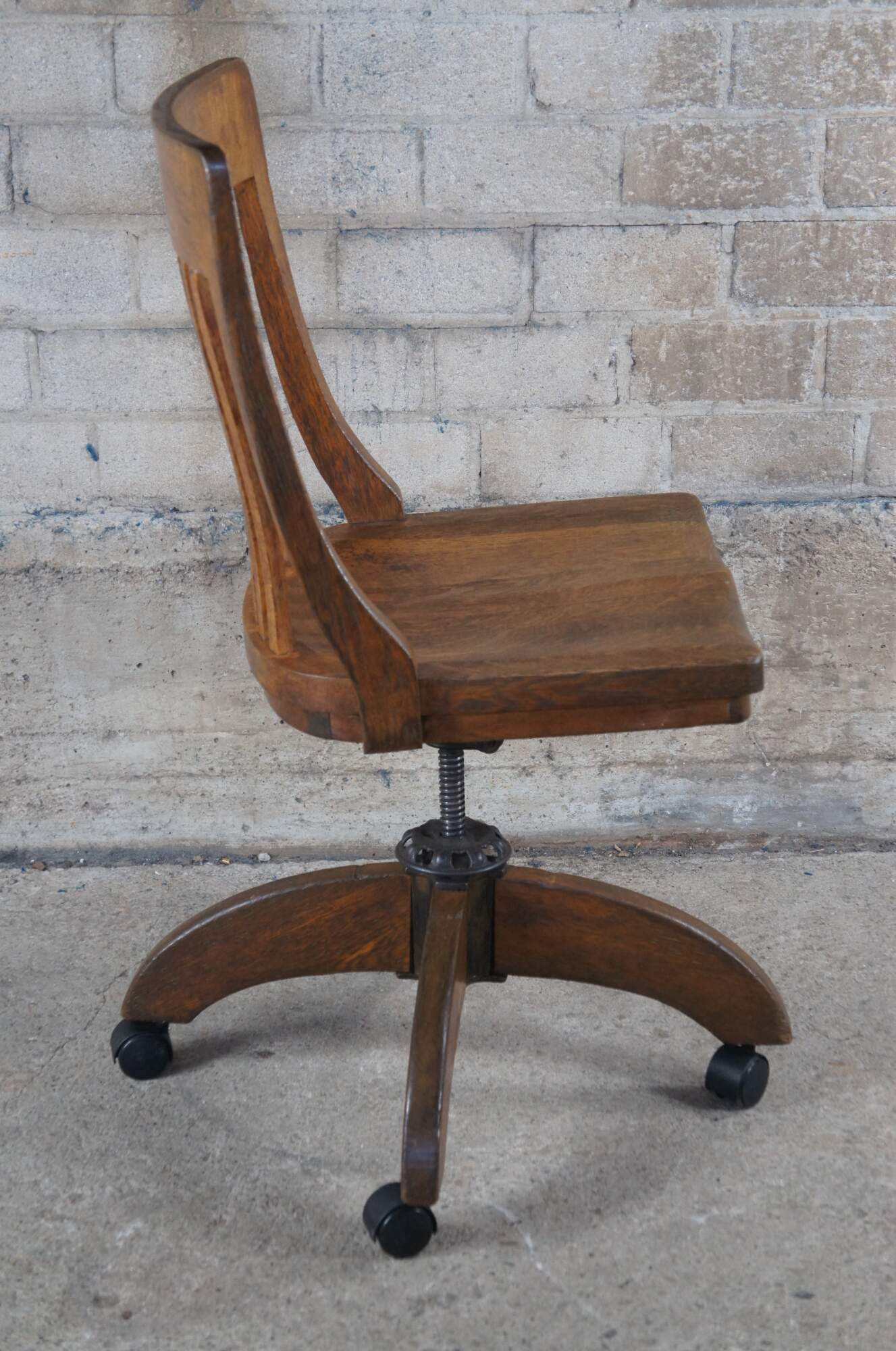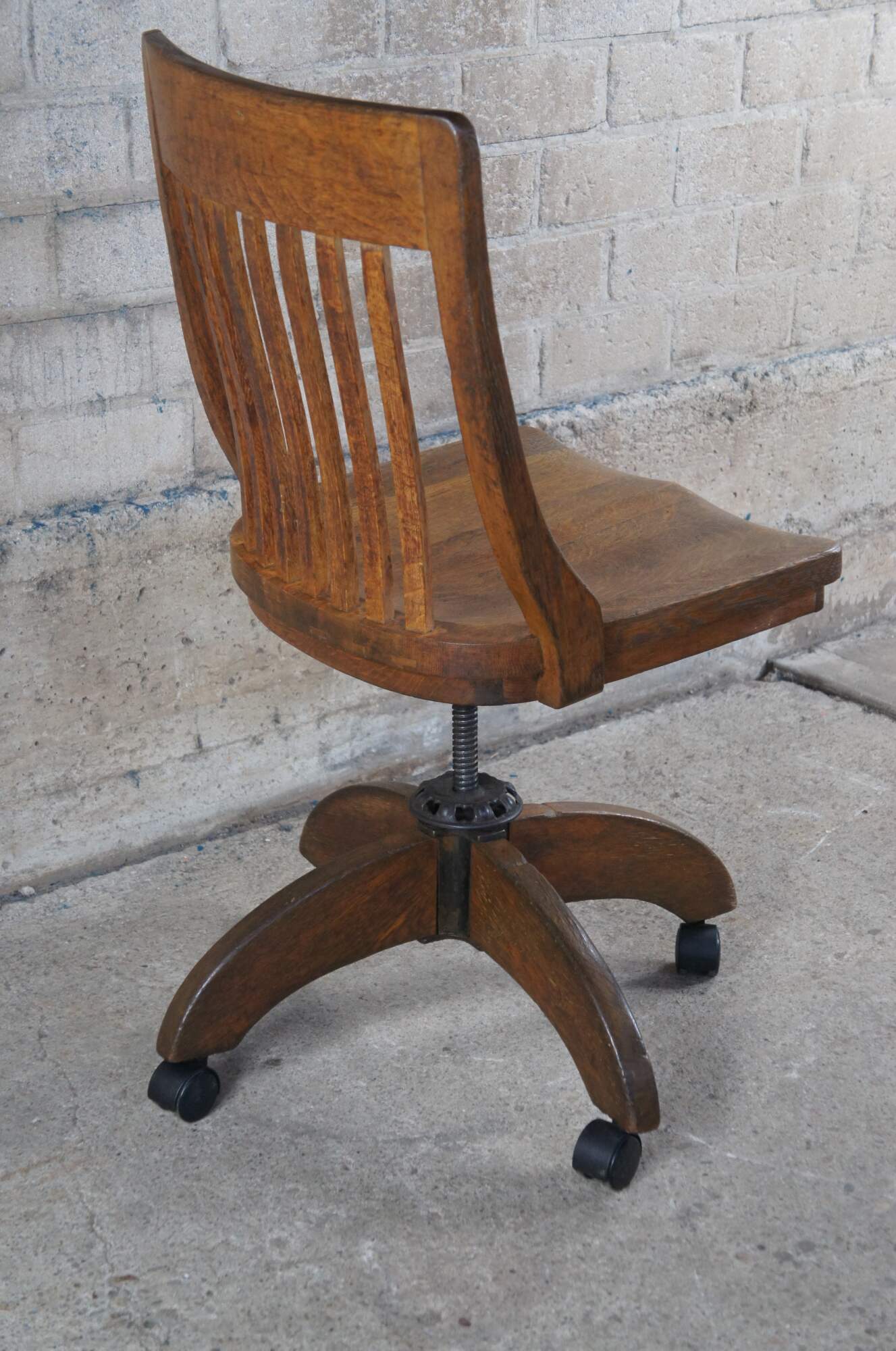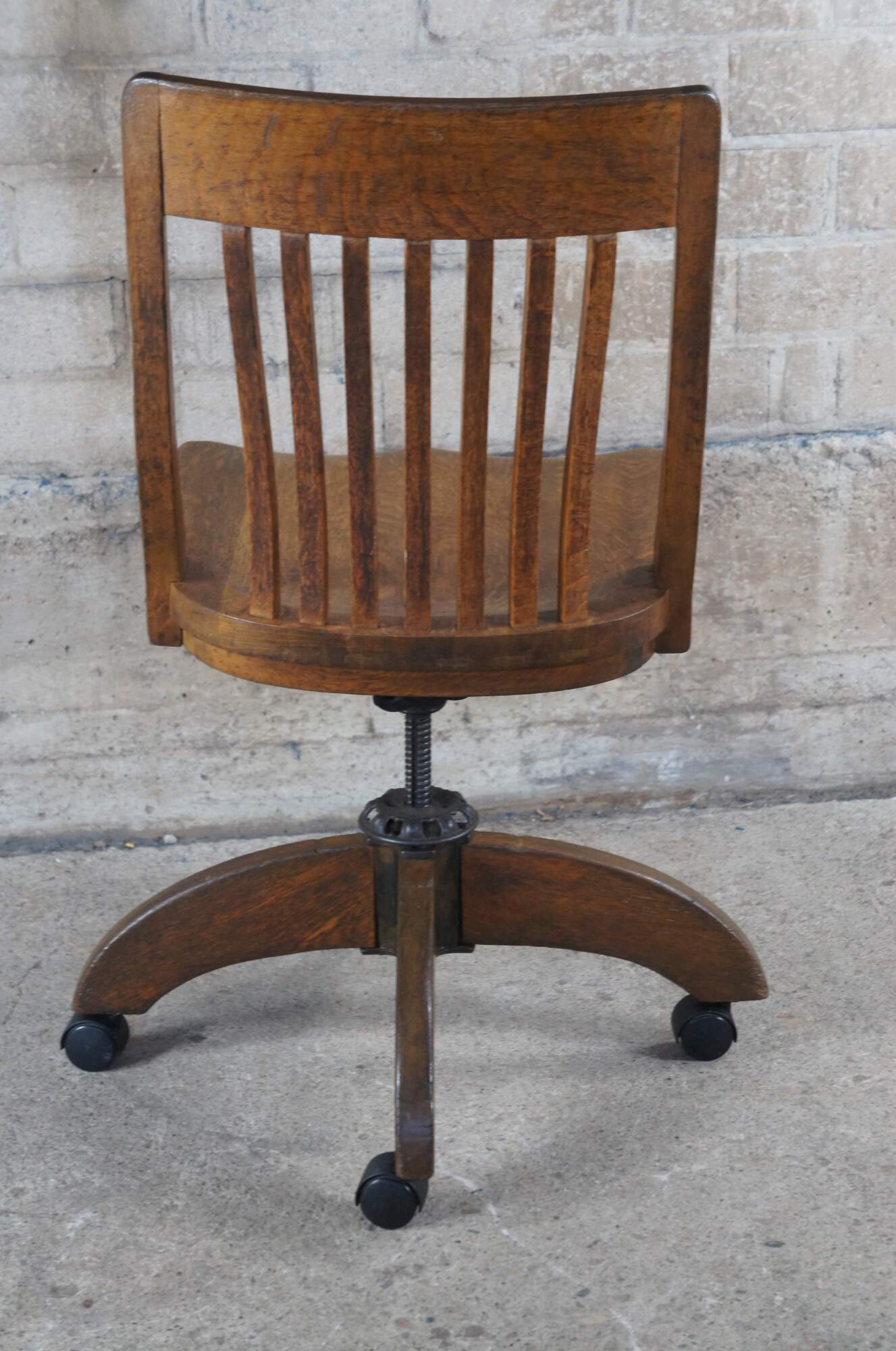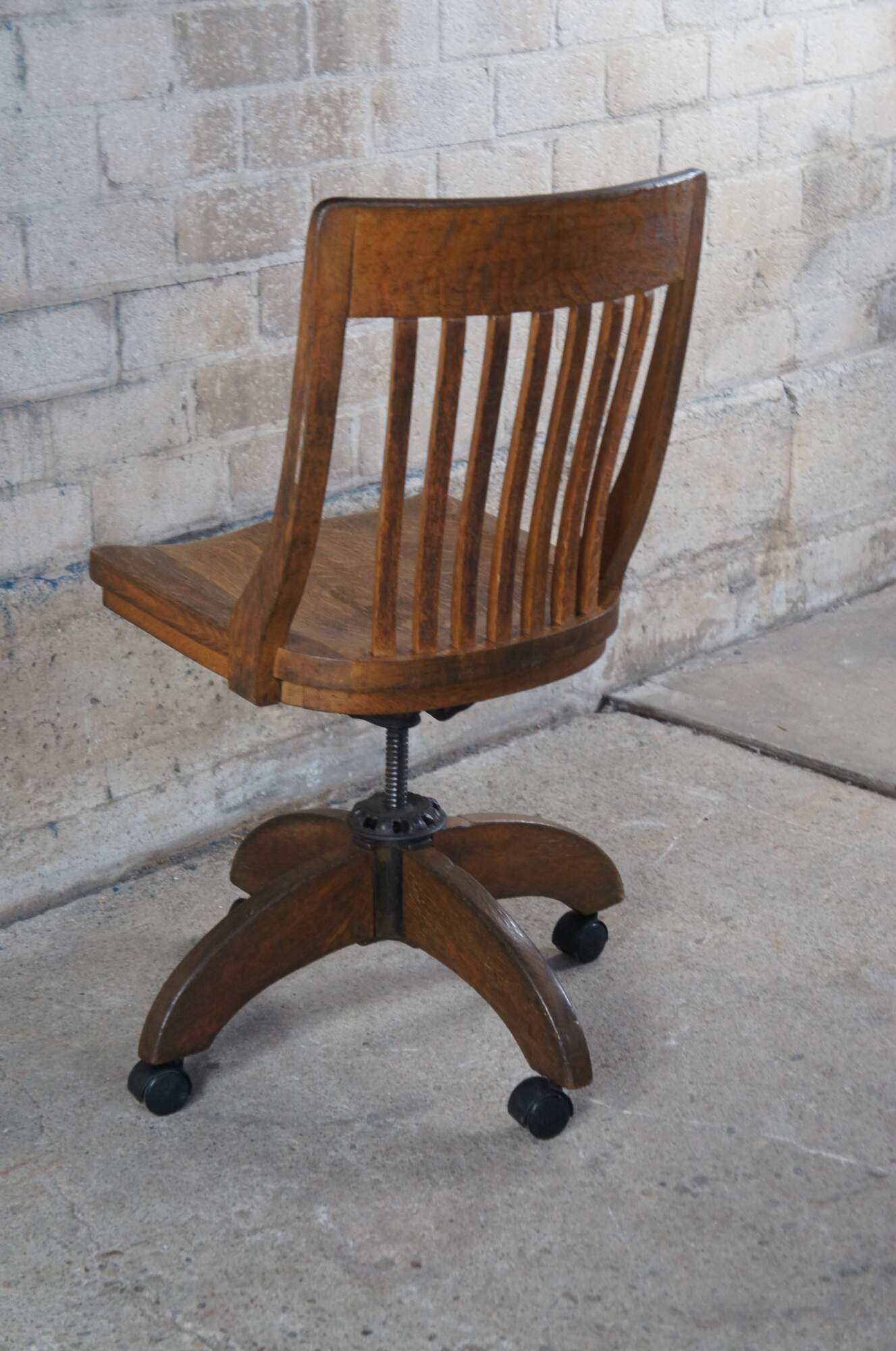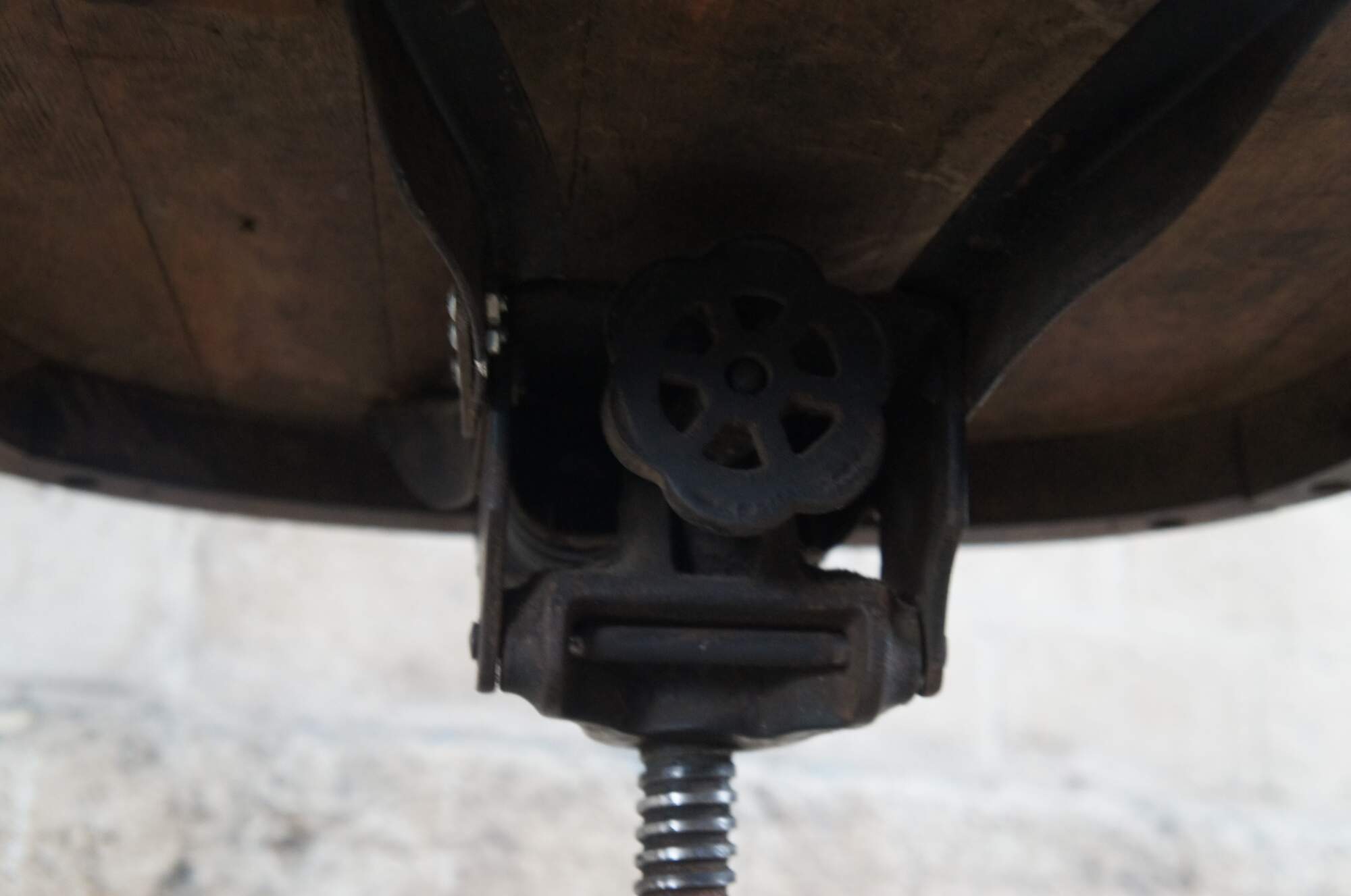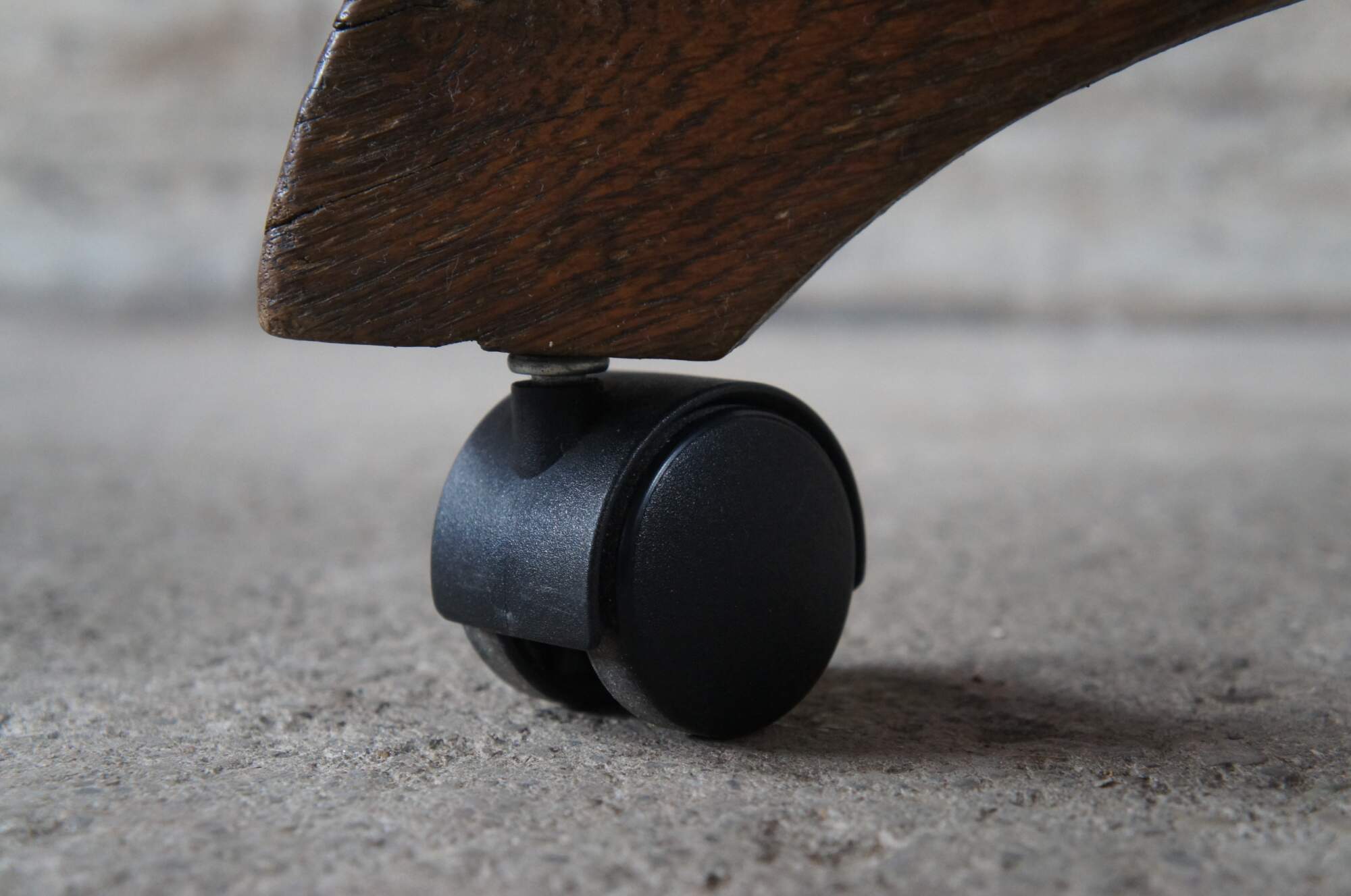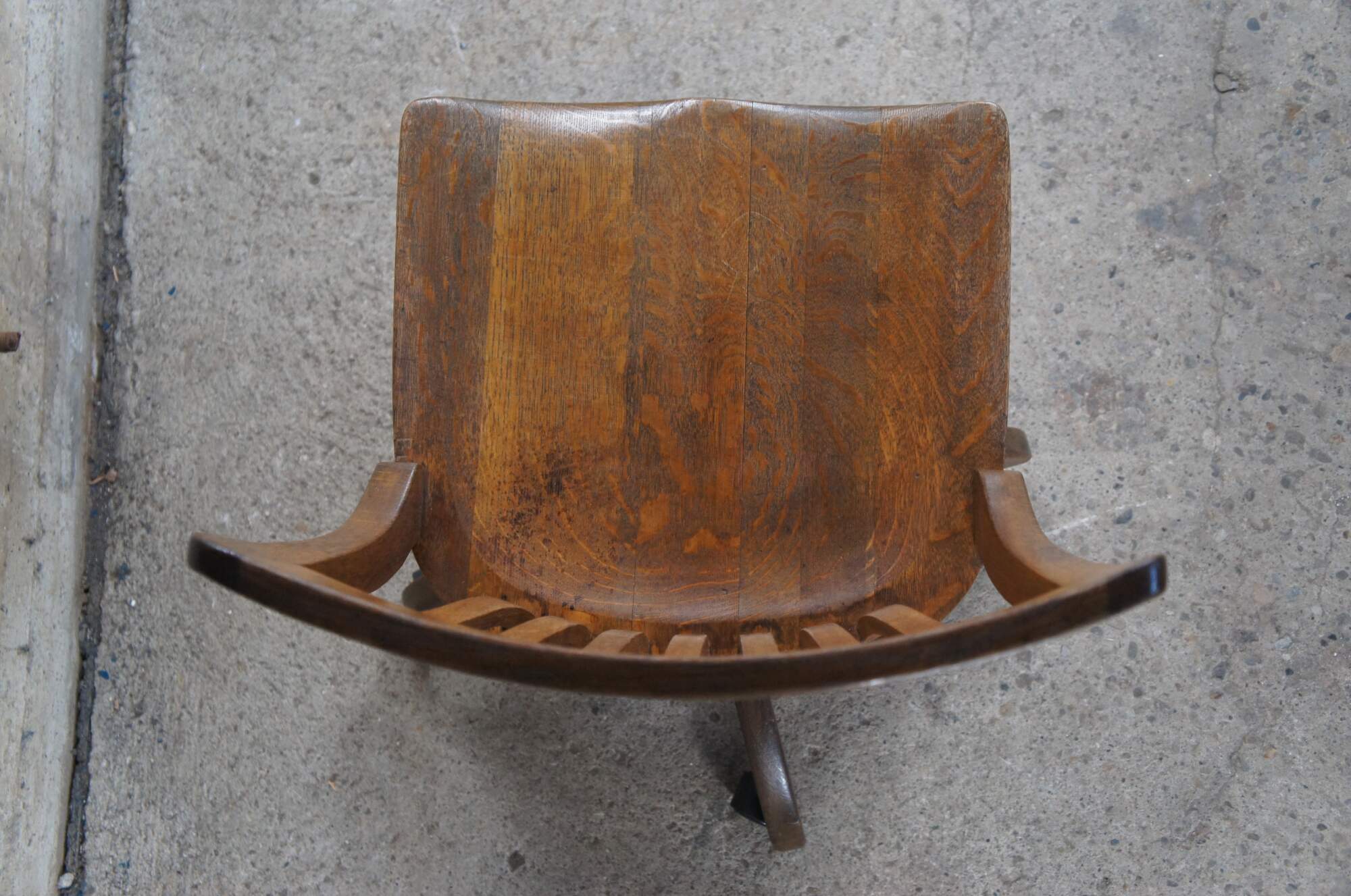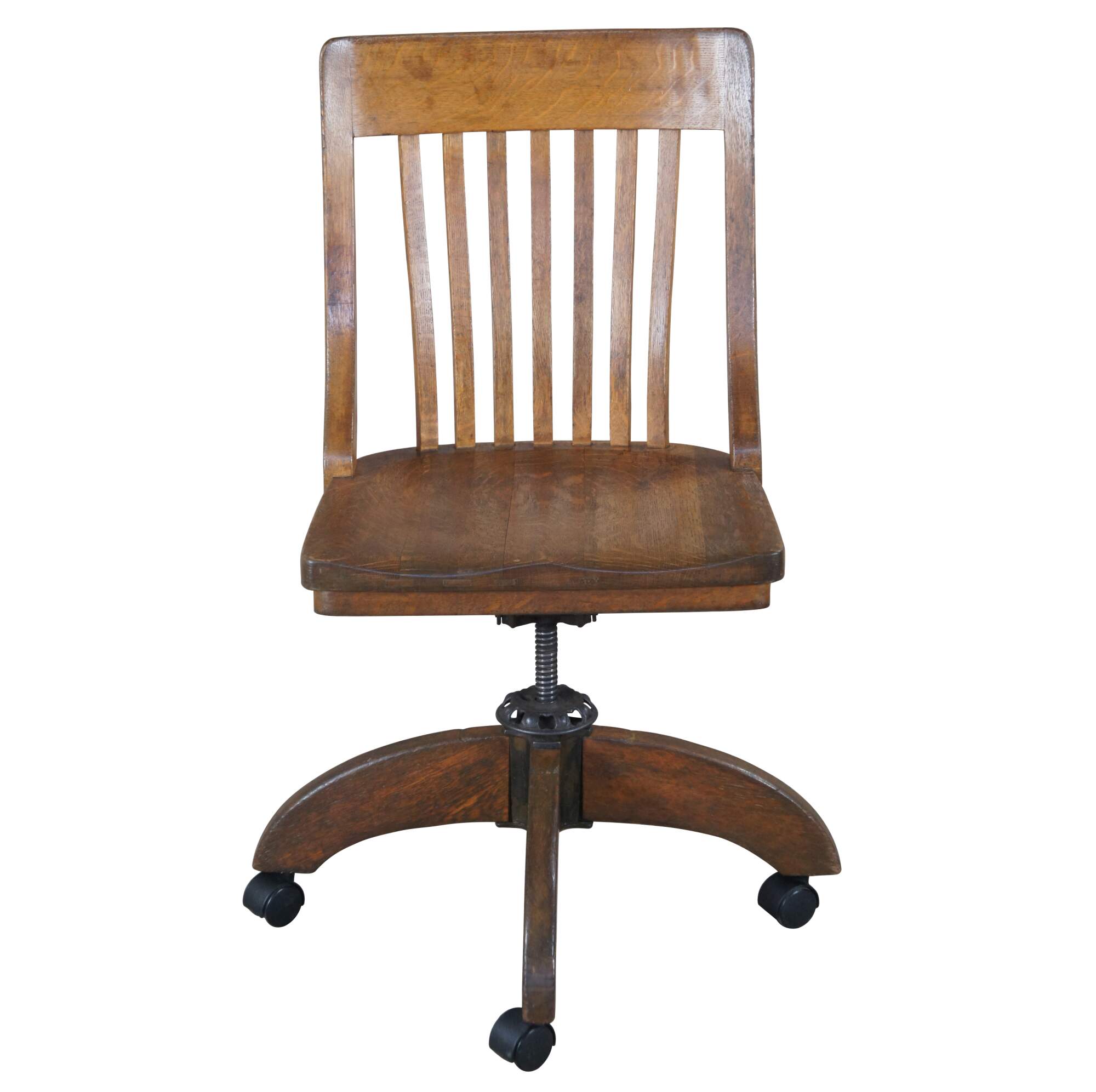
Antique WH Gunlocke Quartersawn Oak Adjustable Swivel Library Office Desk Chair
Sold
Shipping:
Free Shipping Included
Delivery:
Estimated 2-15 Business Days
Payments:
Credit Card, Check, Cash, PayPal, Apple Pay, Venmo
Returns:
30 Days 100% Money Back Guarantee, Buyer Pays Return Shipping
Description
Antique W.H. Gunlocke quartersawn oak bankers / lawyers / executive desk chair featuring a slatted back and adjustable swivel recline.
William Henry Gunlocke entered the chair business in Binghamton in 1888 as a wood finisher and rose to the position of factory superintendent. He and four other men came to the village of Wayland in western New York in 1902 in response to a newspaper advertisement placed by the civic fathers seeking to fill a vacant factory building. The W.H. Gunlocke Chair Co. began production there with less than a dozen employees. Its initial offerings included bedroom, library, lounge, and rocker chairs. By 1904 the company was employing 40 people and had begun the first of many plant expansions. By 1911 its payroll had reached 100.
Gunlocke’s reputation for quality designs and craftsmanship was due in part to its extensive use of steambending. By 1912 an entire department had been devoted to this time-honored but exacting process, which had been abandoned by many manufacturers in favor of less costly bandsawing. Gunlocke’s practice was to air-dry wood for six months to one year before using it. This process, plus kiln drying, was essential to producing the company’s durable furniture, including seating made to last for decades. Although the company’s furniture was initially designed, manufactured, and merchandised primarily for household applications, it found a growing market in business settings and began to specialize in furniture for business and government offices, as well as for the nation’s schools. Woodrow Wilson became the first of a long line of presidents to use one of its chairs.
Gunlocke received its first national corporate contract from Western Electric in the 1920s. This contract required the company to produce furniture in large quantities while meeting rigid quality specifications and delivery schedules. Similar contracts followed with other private firms and the federal government. Throughout the Depression, Gunlocke continued to grow. By the time William Gunlocke died in 1937, the company payroll had grown to more than 300 and a second factory was in operation in Cortland, New York.
Howard W. Gunlocke, William’s son, succeeded his father as company president. The most significant of his innovations was the establishment of manufacturer’s representatives, and later showrooms, in key buying centers across the country—still unusual at a time when most sales were being made through catalogs and by traveling salesmen. Howard Gunlocke was still the company’s chief executive in January 1969, when it was sold to the Sperry and Hutchinson Co. for $16.5 million.
At this time Gunlocke was one of the largest manufacturers of quality wooden seating for offices, schools, libraries, and other institutions. All presidents since Wilson had used a Gunlocke chair (a tradition that continued into Jimmy Carter’s term of office), and these chairs had been in the Oval Office under every president since Herbert Hoover. The company’s furniture was in use in some 35 state legislatures, and it was also the nation’s leading supplier of seating for colleges and universities. These were special-order customers with their own specifications, for which Gunlocke was manufacturing furniture in addition to its regular product lines, principally for the medium-and higher-priced markets.
Gunlocke also was producing tables, upholstered chairs, and lounge furniture in a variety of contemporary and traditional styles for the same institutional markets. The principal raw materials were selected hardwoods, such as walnut, maple, and oak. In addition, various natural and synthetic fabrics and fibers, produced by others, were being used by Gunlocke as upholstery. Aside from the principal Wayland factory, the company had smaller plants in Dallas; Whittier, California; and Almond, New York, at this time. It had more than 400 employees, and its furniture was being sold by about 1,000 dealers in all 50 states. Sales came to about $10 million in fiscal 1968.
The firm was renamed The Gunlocke Company, Inc. and became a unit of Sperry and Hutchinson’s interior-furnishings group. This allowed it representation in the permanent showroom S&H maintained in High Point, North Carolina. The company continued under Howard Gunlocke’s direction as president and chairman of the board. Record sales and earnings were achieved in 1969, and the number of dealers through which the company was marketing its furniture grew to more than 1,300 by 1971.
Gunlocke launched two new lines of lounge furniture in this period to increase its penetration of the higher-education market and began producing desks, credenzas, bookcases, and storage units. In the initial stages of the program, lumber storage capacity was increased by 30 percent, and the rough mill and steam-bending departments (the first stages of chair production) were expanded. New equipment, including an overhead conveyor system to transport chairs, was intended to facilitate future expansion. These changes required a major expansion of the Wayland facility, completed in 1973, and of the nearby Almond upholstery unit.
Gunlocke won honors for design from the National Office Products Association in 1970. In the same year the Institute of Business Designers presented an award to a new Gunlocke armchair and simultaneously to the designer, Jens Thuesen of the company staff. The company opened a new showroom in Chicago’s Merchandise Mart in early 1971. Gunlocke’s customers at this time included New York University, the University of Tulsa, the Minnesota House of Representatives, the Eastman Kodak Co., and People’s State Bank in Marshall, Texas.
By acquiring Sjostrom U.S.A., Inc. in 1972, Gunlocke added a full line of high-quality library furniture. In 1973 it had showrooms in Los Angeles, New York City, and Dallas, as well as Chicago. Its product line in 1974, aside from seating, desks, credenzas, and library furniture, included conference and side tables. These products were made primarily from solid walnut, maple, and white oak, as well as veneers of these woods. Along with seven other companies, Gunlocke became a member of S&H’s new furnishings division in 1974 and subsequently became the parent company’s contract-furniture division. The Almond plant was closed in 1976. In 1977 Gunlocke introduced a new desk series and three chair styles by leading designers.
Sperry and Hutchinson was sold off in several parcels during 1981, with Gunlocke purchased by its own officers for an undisclosed sum. The company had estimated sales of about $25 million that year. Under its team of owner/managers, Gunlocke enjoyed several years of unprecedented growth. In 1987, when the company was sold to Chicago Pacific Corp., its sales were estimated at $60 million, and it had plants in Wayland and Avon, New York.
Chicago Pacific made Gunlocke the core company for a newly formed contract office-furniture division. By this time Gunlocke had added office panel systems to its products. Chicago Pacific noted that the company was using a patented system known as the SteamFold process to bend wood into carefully crafted attractive seating designs. It was maintaining its own sales force and showrooms in most major U.S. cities and distributing its products to more than 600 independent furniture dealers nationwide. Gunlocke introduced the ergonomic Exel 3 line of modern seating in 1987 and was planning to introduce Estro, a contemporary addition to its Geva line of modular case goods, in 1988.
The company’s affiliation with Chicago Pacific was shortlived, however, for in January 1989 Chicago Pacific was merged into Maytag Corp. Within a few months Maytag had sold the entire furniture division to LADD Furniture Inc., which, before the year was out, sold Gunlocke to HON INDUSTRIES Inc. for $34 million in cash and notes. In 1990 HON assigned Gunlocke’s Avon plant to another company unit, converting it to the manufacture of low-end office products. Gunlocke was one of seven HON companies in the field of office products and furniture at this time. Only four remained in 1996.
In 1993 Gunlocke was selected to assume the market served by CorryHerbert, a HON company dissolved in 1994 that had been producing metal office furniture. Despite this addition to its product line, all was not well at the firm. After increasing sales significantly in 1993, Gunlocke lost ground the following year. The company had relinquished market share in the high-end, wood office-furniture market, a market that itself had contracted, partly because of widespread corporate downsizing. As a result, Gunlocke downsized its own operations, cutting its labor force in 1995 to 650, compared with 850 early in the previous year.
Condition
Good antique condition, wear and distressing commensurate with age and use, casters were replaced at some point.
Dimensions
18.75" x 19" x 34"h, seat 16"; telescopes to 38"h w 21" seat height
